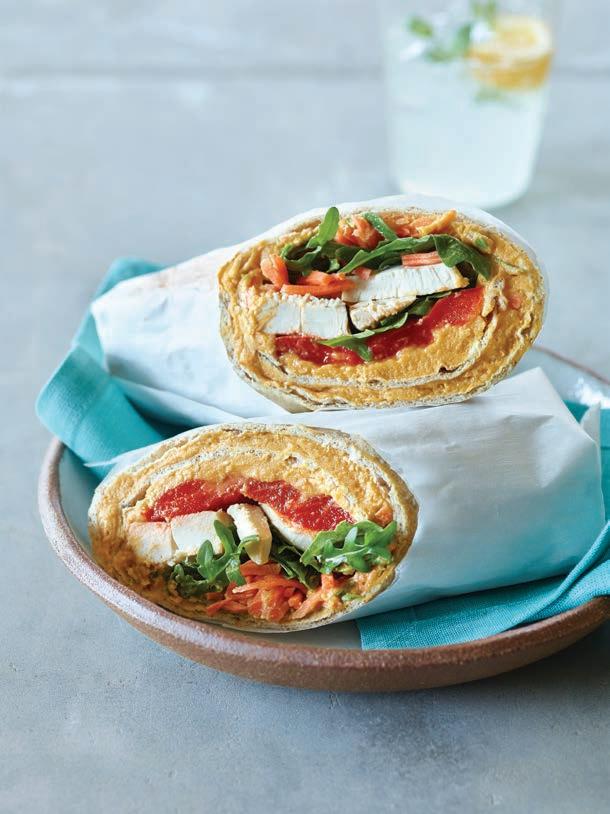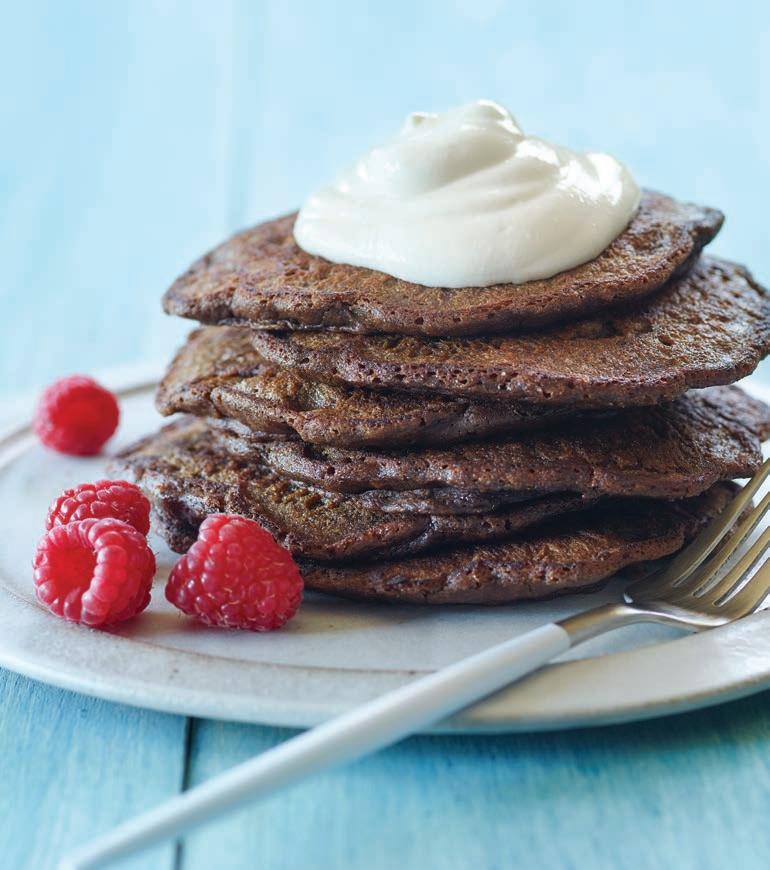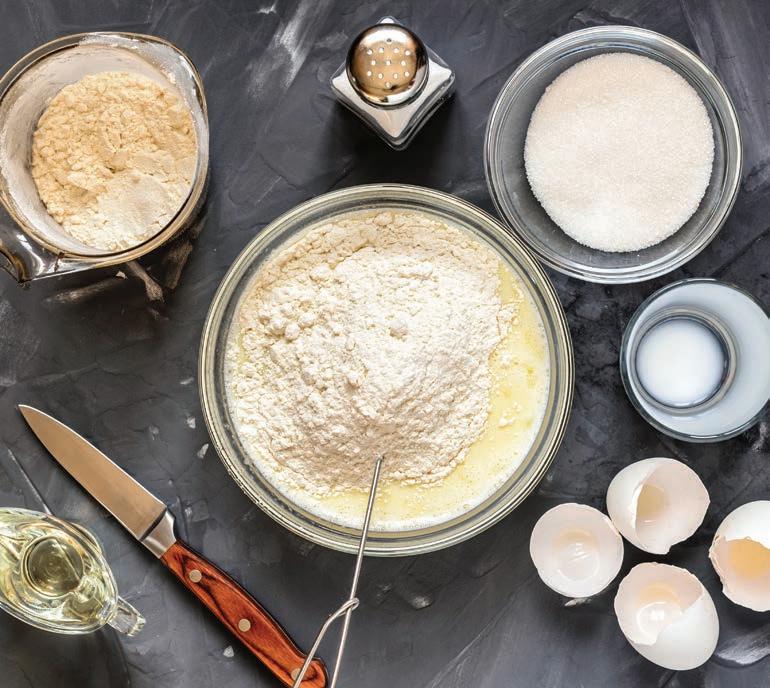
10 minute read
Pump Up the Protein
Protein Pump up the
Protein powders aren’t just for boring shakes! These five recipes incorporate them in new and exciting ways BY MATTHEW KADEY, MS, RD
Advertisement
When it comes to what we eat, it’s best not to overlook protein. Most active people require about 1.5 grams of protein for every kilogram they weigh (that’s 89 grams for a 130-pound person). Protein helps build lean body mass (aka muscle) and keeps you feeling satiated to stamp out overeating, and protein powder is an easy and convenient way to help make sure you get what you need. But most people think of whey, soy, and other guises of protein powder as only something to blend into smoothies and chug down after a workout or when in need of a quick breakfast. And while protein powders are perfect for that, there are so many other ways to use them in the kitchen as ultra-versatile ingredients. As these recipes show, you can employ protein powders to boost the muscle-building power of everything from baked goods to oatmeal to soups without needing the shaker cup.

Sweet Potato Hummus Chicken Wraps
Makes 4 wraps Nobody will be the wiser that you snuck protein powder into this creamy sweet potato spread to turn the lunch wrap into an even bigger protein powerhouse. You can make it veganfriendly by using plant protein powder and swapping out the chicken for tofu. You’ll likely end up with extra hummus, which can be used as a dip or for even more sandwiches. 1 medium sweet potato, peeled and diced 1 cup cooked or canned chickpeas ⅓ cup plain protein powder 3 Tbs. tahini Juice of ½ lemon 1 garlic clove, minced 2 Tbs. extra virgin olive oil 1 tsp. smoked paprika ½ tsp. cumin powder ½ tsp. salt 4 whole-grain bread wraps 4 cups baby greens or arugula 1½ cups sliced cooked chicken 2 large carrots, cut into matchsticks 1 cup sliced roasted red pepper
1. Steam or boil sweet potato until very tender. Let cool. 2. Place cooked sweet potato, chickpeas, protein powder, tahini, lemon juice, garlic, olive oil, paprika, cumin, and salt in food processor or blender, and blend until smooth. 3. Spread hummus on wraps, and place an equal amount of greens, chicken, carrot, and roasted red pepper on bottom third of each wrap. Roll wraps tightly, tucking in sides as you roll. Slice on bias. Per wrap (with whey protein powder): 540 cal; 39g prot; 19g total fat (4g sat fat); 54g carb; 74mg chol; 1,130mg sod; 9g fiber; 11 g sugar
Masala Cauliflower Soup Serves 4 Creamy soups are a great opportunity to sneak some more vegetables and—surprise, surprise—protein into your diet. This heavenly spiced soup is a nutritious companion to any meal. 1 Tbs. grapeseed oil 1 yellow onion, chopped ½ tsp. salt 1 head cauliflower, cut into small florets 2 garlic cloves, chopped 1 Tbs. ginger, chopped 1 Tbs. garam masala powder ¼ tsp. cayenne powder ¼ tsp. black pepper 2 cups low-sodium vegetable broth ⅓ cup unflavored protein powder Juice of ½ lime 1 cup unsweetened plain cashew milk 1 cup crunchy chickpeas (optional) ½ cup cilantro, chopped
1. Heat oil in large saucepan over medium heat. Add onion and salt; cook until onion has softened and is beginning to darken, about 5 minutes. Add cauliflower, garlic, and ginger to pan, and heat 3 minutes. Stir in garam masala, cayenne, and black pepper, and heat 30 seconds more. Pour in broth and 2 cups water. Bring to a boil, reduce heat to low, cover, and simmer 20 minutes. 2. Place soup in blender or food processor, along with protein powder and lime juice, and blend until very smooth. Return to pan, stir in cashew milk, and heat through. 3. Divide soup among serving bowls and garnish with crispy chickpeas (if using) and cilantro. Per serving (with whey protein powder): 160 cal; 14g prot; 6g total fat (1g sat fat); 15g carb; 30mg chol; 460mg sod; 4g fiber; 7g sugar

PB & J Oatmeal Serves 4 This creamy oatmeal tastes like everyone’s favorite schoolyard sandwich, albeit one with more lofty protein levels. Soaking hearty steel-cut oats overnight slashes their cooking time to make this breakfast more conducive to harried mornings. Whole nuts and coconut chips are a great way to add a satisfying crunch.
1½ cups fresh or frozen (thawed) strawberries 1 Tbs. honey 2 Tbs. chia seeds 1 cup steel-cut oatmeal ⅓ cup milk or unsweetened dairy-free milk ½ cup plain or vanilla protein powder ¼ cup natural peanut butter 1 tsp. cinnamon ¼ cup unsalted roasted peanuts (optional) ¼ cup coconut chips (optional)
1. Blend together strawberries, honey, and 2 Tbs. water. Place strawberry purée in container or bowl and stir in chia seeds. Set aside at least 1 hour to thicken. 2. Place oats, a pinch of salt, and 3 cups water in medium-sized saucepan. Bring to a mild boil, immediately turn off heat, cover, and let oats soak overnight. 3. In the morning, stir milk, protein powder, peanut butter, and cinnamon into oats, and cook over medium-low heat, 5 minutes, stirring occasionally. 4. Divide oats among serving bowls and swirl in strawberry-chia jam. Garnish with peanuts and/or coconut chips if desired.
Per serving (with whey protein powder):
390 cal; 27g prot; 14g total fat (2.5g sat fat); 43g carb; 50mg chol; 115mg sod; 6g fiber; 10g sugar

Mocha Oat Pancakes Makes 8 pancakes (4 servings) These fluffy, protein-packed pancakes are sure to perk up your weekend mornings. You can also spread some nut butter and/or cream cheese between two leftover pancakes for an ultimate fast-food breakfast sandwich. ² ⁄ ³ cup rolled oats ¾ cup brewed coffee ½ cup milk or unsweetened dairy-free milk ¾ cup oat flour ¼ cup chocolate or vanilla protein powder 2 Tbs. cocoa powder 1 tsp. cinnamon ¼ tsp. cayenne (optional) 1 tsp. baking powder ½ tsp. baking soda 1 large egg, lightly beaten 2 Tbs. melted butter or coconut oil 1 tsp. vanilla extract (omit if using vanilla protein powder) ¼ cup chopped walnuts 1 cup plain Greek yogurt 2 Tbs. pure maple syrup 1 ½ cups raspberries

1. Combine oats, coffee, and milk in large bowl, and set aside 10 minutes. 2. In separate bowl, stir together flour, protein powder, cocoa powder, cinnamon, cayenne if using, baking powder, baking soda, and a pinch of salt. Stir egg, butter or coconut oil, and vanilla into oat-coffee mixture. Add wet ingredients to dry ingredients, mix gently, and fold in walnuts. 3. Heat a greased skillet or griddle pan over medium heat. Pour ¼ cup batter for each pancake into pan, and cook until tops are covered with a few bubbles and edges look dry and cooked, about 2 minutes. Flip, and cook 1 minute more. Keep prepared pancakes warm in oven set to 200°F while you cook remaining batter. 4. Stir together yogurt and maple syrup. Serve pancakes topped with dollops of maple yogurt and raspberries.
Tips for Successfully Cooking with
Protein Powder Cooking with protein powder isn’t rocket science, but it’s also not something you can do without any thought. Keep these tips in mind the next time you reach for your power powder.
FLAVOR MATTERS: It’s important to pick the right flavor of protein powder for your recipe. After all, chocolate protein powder may not go over too well in a soup. Try stirring a berry-flavored powder into yogurt, mixing a vanilla powder in muffins, and using a plain powder for savory applications.
HOLD THE WHEY: When used in baked goods such as muffins, whey or casein powders have a tendency to cause a rubbery, less-tender texture if used too liberally. Generally, you don’t want to replace more than 25 percent of the flour in a recipe with whey protein powder or you’ll risk eating something that tastes like a tire. For better texture, try using plant-based protein powders for baking purposes.
LIQUID ASSETS: When stirring whey or veggie powders into batters, add a little bit more of a moisturizer such as yogurt, applesauce, or pumpkin purée to avoid dry results. Also, don’t overmix the batter—stir gently just until everything is moist.
TURN DOWN THE HEAT: A slightly lower baking temperature—say 325°F instead of 350—will help keep protein powder-infused baked goods moister.
BURY THE SCOOP: Many powders come with a scoop that is convenient when adding the protein to items like smoothies. But for recipes such as muffins and pancakes, where you want to use a specified amount, it’s best to measure out the powder using measuring cups.
THE COVER UP: Some powders such as pea and hemp can impart earthy flavors to dishes. Using ingredients like cinnamon, mashed banana, or cocoa can help mask these tastes.


Banana Protein Muffins
Makes 12 muffins These grain-free, banana-bread-like muffins taste more naughty than they are. Enjoy one as a quick snack or guilt-free dessert. If you like, the hazelnut flour can be replaced with almond flour.
2 large eggs ¼ cup milk or unsweetened dairy-free milk 3 medium-sized very ripe bananas, peeled ¼ cup honey or maple syrup 1½ cups hazelnut meal/flour ½ cup plain or vanilla plant-based protein powder 1 tsp. cinnamon ½ tsp. baking powder ½ tsp. baking soda ¼ tsp. salt ½ cup dark chocolate chips
1. Preheat oven to 350°F. Place eggs, milk, bananas, and honey in blender or food processor, and blend until smooth. Blend in hazelnut flour, protein powder, cinnamon, baking powder, baking soda, and salt. Stir in chocolate chips. 2. Divide batter among 12 standard-sized greased or paper-lined muffin cups. Bake 22–25 minutes until set and lightly browned on top, so that a toothpick inserted into center of muffin comes out nearly clean. Let cool a few minutes before unmolding and cooling completely on metal rack. Chill up to five days.
Per muffin (with plant-based protein powder):
230 cal; 10g prot; 13g total fat (3g sat fat); 22g carb; 30mg chol; 230mg sod; 3g fiber; 15g sugar
Collagen 101
BY MARY ANN O’DELL, MS, RDN
COLLAGEN IS AN IMPORTANT structural protein in the body. In fact, it’s the most abundant protein in the body. It is the most integral part of the skin’s fabric, giving skin the youthfulness and tautness so many desire. It’s also a building block for bones, muscles, and tendons, and it is found in blood vessels, teeth, and the cornea of the eyes.
There are more than 20 types of collagen, but types I, II, and III are the most prevalent in the human body, with types I and III being found mainly in the skin. As we age, the collagen in our bodies can get weaker, and our body’s production of collagen slows down. In addition to age, excess sun exposure, smoking, and excessive sugar can all damage and weaken collagen in the body.
To enhance collagen, make sure you’re getting enough collagen building blocks, including vitamin C, glycine, and copper, along with protein. A great way to do this is to incorporate bone broth into your diet. In addition, collagen supplements offer a convenient way to boost collagen intake.
BENEFITS OF COLLAGEN
Gut Health. Collagen is part of the connective tissue in the gut, and it can help support the lining of the intestinal tract. This can result in less inflammation and improved functioning of the intestinal tract.
Joint Health. Collagen plays a role in joint health and structure, so it is commonly used by those dealing with joint pain. Research suggests that collagen use may help reduce pain associated with osteoarthritis.
Lean Muscle. Hydrolyzed collagen contains high ratios of nitrogen rich amino acids, such as glycine & proline, important in muscle protein synthesis. This helps support the body’s ability to maintain lean muscle tissue, which in turn can facilitate fat loss. Studies have demonstrated that consuming collagen and utilizing strength training enhanced lean muscle mass in older men more than strength training alone.
Youthful Skin. As we age, we lose collagen, which contributes to signs of aging, including wrinkles and dry skin. Ingesting collagen has been found to help support the body’s production of collagen, improving overall skin health and counteracting signs of aging. Collagen is often found with hyaluronic acid, which helps keep collagen, and skin, hydrated and youthful.


NaturesPlus Collagen Peptides
Multi-collagen formula, with types I, II, III, IV, V, and X. Derived from grass-fed cows, sustainably caught fish, cage-free chicken, and eggshell membrane. Supports soft skin, strong nails, hair growth, gut health, and joint relief.*










